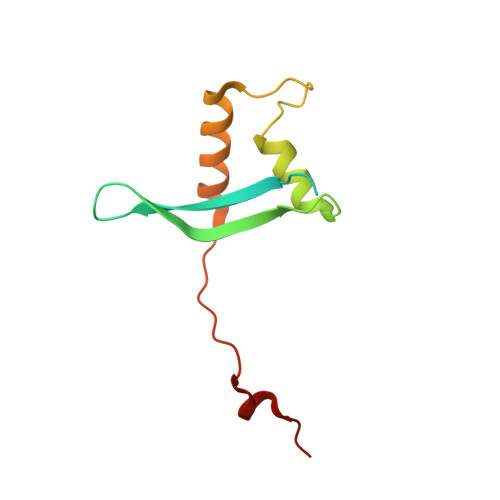'Drc', a structurally novel ssDNA-binding transcription regulator of N4-related bacterial viruses.
Boon, M., De Zitter, E., De Smet, J., Wagemans, J., Voet, M., Pennemann, F.L., Schalck, T., Kuznedelov, K., Severinov, K., Van Meervelt, L., De Maeyer, M., Lavigne, R.(2020) Nucleic Acids Res 48: 445-459
- PubMed: 31724707
- DOI: https://doi.org/10.1093/nar/gkz1048
- Primary Citation of Related Structures:
6QLC - PubMed Abstract:
Bacterial viruses encode a vast number of ORFan genes that lack similarity to any other known proteins. Here, we present a 2.20 Å crystal structure of N4-related Pseudomonas virus LUZ7 ORFan gp14, and elucidate its function. We demonstrate that gp14, termed here as Drc (ssDNA-binding RNA Polymerase Cofactor), preferentially binds single-stranded DNA, yet contains a structural fold distinct from other ssDNA-binding proteins (SSBs). By comparison with other SSB folds and creation of truncation and amino acid substitution mutants, we provide the first evidence for the binding mechanism of this unique fold. From a biological perspective, Drc interacts with the phage-encoded RNA Polymerase complex (RNAPII), implying a functional role as an SSB required for the transition from early to middle gene transcription during phage infection. Similar to the coliphage N4 gp2 protein, Drc likely binds locally unwound middle promoters and recruits the phage RNA polymerase. However, unlike gp2, Drc does not seem to need an additional cofactor for promoter melting. A comparison among N4-related phage genera highlights the evolutionary diversity of SSB proteins in an otherwise conserved transcription regulation mechanism.
Organizational Affiliation:
Department of Biosystems, Laboratory of Gene Technology, KU Leuven, Leuven 3001, Belgium.















